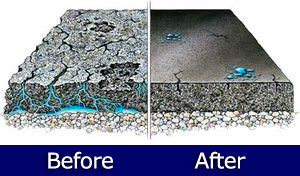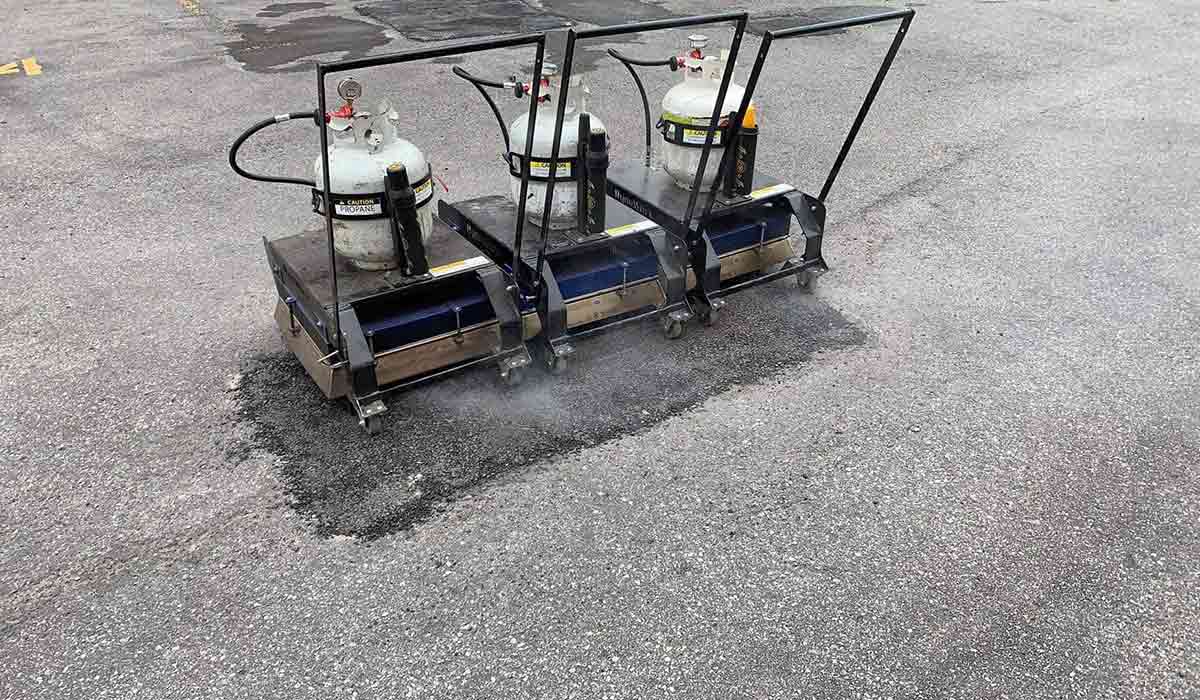Table of Contents
One of the most important parts of asphalt maintenance is parking lot crack repair.
In fall and winter, water gets into the cracks and as it freezes, it swells, causing the crack itself to expand and get larger. Dealing with cracks in asphalt as soon as you spot them stops water from penetrating cracks and causing further damage to the pavement's foundation.
Be Proactive with Asphalt Crack Repairs!
It is important to have an asphalt crack repair program to protect your asphalt investment. When left untreated, seemingly simple cracks become parking lot pot holes, sunken areas or even large crevices.
Before you know it, you're looking at expensive repairs and in extreme cases – replacement. And you don't want that.
But you're worried about the high cost of hiring parking lot crack repair out. With the recent price increases on both supplies and labor, hiring a contractor with rates that match your budget is looking more and more like a pipe dream.
If that is the case, then worry no more. With Asphalt Kingdom's DIY crack repair solutions, you can save thousands of dollars and extend the lifespan of your parking lot by four years or even more!

An asphalt crack before and after repair
Here are some quick facts:
- Contractors charge $1/linear foot for crack repairs.
- With a full pallet of crack filler, you can save over $10,000 doing it yourself.
- 70% of unsealed cracks develop into potholes within 3 years.
- Repairing cracks reduces future cracking by 75%.
- If you get potholes, then you will really have to spend some money to fix them!
Crack repairs are important to the longevity of your pavement. The good news is that if you can push a shopping cart, you can do this yourself! You just need the right equipment, supplies, and support to get the job done right.
DIY Parking Lot Crack Repair Equipment
If you want the best crack repair equipment to use to fill cracks in your parking lot but don't know where to start, then you've come to the right place.
Choosing the right asphalt crack sealing equipment can depend on the size of the parking lot and the kind of cracks that appear on the asphalt surface.
H.M.B. Church saved over $4,000 doing crack repairs themselves
We have plenty of crack filling equipment for you to choose from, but let us introduce you to one of our best-sellers:
RY10 PRO Crack Seal Melter & Applicator Machine
Light the RY10 Pro like a BBQ and push like a shopping cart
The RY10 PRO is one of Asphalt Kingdom's best-selling asphalt crack filling machines. This high-capacity crack seal melter and applicator lets you conduct DIY crack repair at walking speed while saving you thousands of dollars in the process. It's also so easy to use! Simply light it up, wait for the rubberized crack fill to melt, and push like a shopping cart.
👉 Interested about this machine? Learn more about the RY10 PRO here! 👈
The RY10 PRO is just one of the many crack filling machine options Asphalt Kingdom has for you. Browse our crackfilling equipment store to choose the crack filler machine that best suits your property's needs and your budget.
Hot Pour Rubberized Crack Filler
 A pallet of crack filler getting delivered to your location
A pallet of crack filler getting delivered to your location
And while we're on the topic, let us introduce you to our Hot Pour Rubberized Crack Filler.
- Each box contains 30 lbs. of professional-grade, rubberized crack filler.
- This is enough to cover approximately 200 linear feet of cracks.
- Using it to seal cracks is a piece of cake. Take it out of the box, melt it, and apply it using a crack filling machine. It's as easy as pushing a lawn mower.
It hardens and expands to seal up the cracks within 30 minutes, and protects cracks from further damage for 3 to 4 years. Talk about long-lasting!
Save more when you order a half pallet or full pallet of crack filler. It has a shelf-life of 10 years and can freeze, so you can fill your asphalt cracks for a long time — think of the savings that will get you!
How you can save thousands with do-it-yourself asphalt crack repairs
How To Conduct DIY Asphalt Parking Lot Crack Repair
DIY crack repair is easy anyone can do it! Check out our short guide on how to fix parking lot cracks below.
- Step 1: Thoroughly clean the crack of all dirt, debris and vegetation.
- Step 2: Fill deep cracks with sand.
- Step 3: Apply hot pour crack filler or cold pour rubberized crack filler to the crack and let it dry.
Watch how easy it is to repair cracks with the RY10 Pro crackfill melter applicator
Cracks should be free of all dirt, grass and weeds before sealing. You can remove any vegetation from the cracks with a crack cleaning machine.
You can also fill the cracks with sand (leaving a half inch in free depth) before you apply a hot pour rubberized crack filler with crack filling equipment.
There is no point using more crack fill than you need to. Keep your costs per linear feet down while making sure that you're doing a quality job.
Smaller cracks, on the other hand, don't require as much preparation and can be blown out with a gas powered blower or compressor. Once the crack has been cleaned from any loose debris, you can then use your portable crack filling machine to seal the cracks.
If there are potholes present in the parking lot, use an asphalt cold patch to fill them quickly and easily.

Before and After Parking Lot Repair
Once you have sealed the parking lot cracks, you should apply a blacktop sealcoat for ultimate surface protection.
You Can Turn Crack Repair Into a Cash Cow, Too!
Got a passion for crack repair?
Looking for a great way to be your own boss, work your own hours, and be outside day after day? Read our free guide to starting your own crack repair business.
Asphalt Kingdom can help
We have a team of expert advisors that are here to provide you with a free expert consultation whether you're a commercial property owner or you're looking to start your own asphalt maintenance business. We can help you with any questions regarding black top crack repair and will be happy to provide you with our honest cut-to-the-chase guidance.









